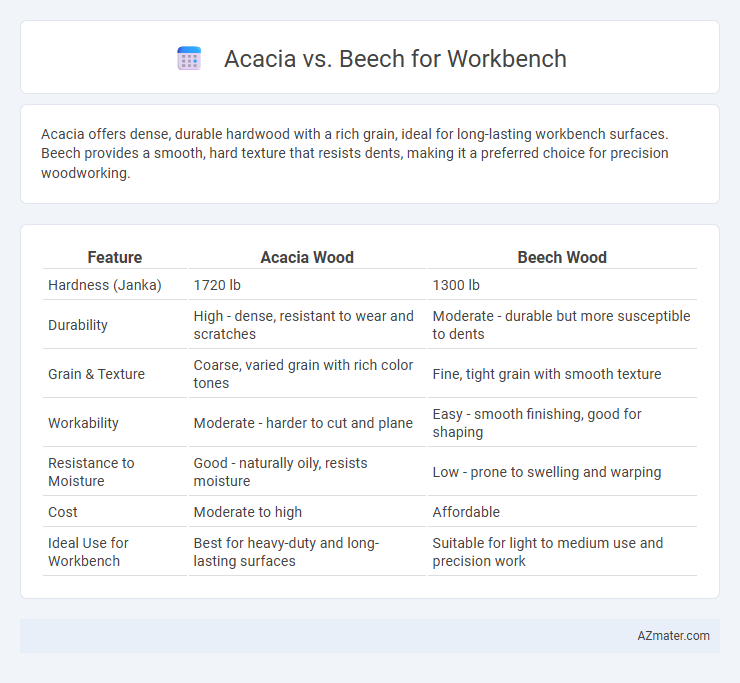Acacia offers dense, durable hardwood with a rich grain, ideal for long-lasting workbench surfaces. Beech provides a smooth, hard texture that resists dents, making it a preferred choice for precision woodworking.
Table of Comparison
| Feature | Acacia Wood | Beech Wood |
|---|---|---|
| Hardness (Janka) | 1720 lb | 1300 lb |
| Durability | High - dense, resistant to wear and scratches | Moderate - durable but more susceptible to dents |
| Grain & Texture | Coarse, varied grain with rich color tones | Fine, tight grain with smooth texture |
| Workability | Moderate - harder to cut and plane | Easy - smooth finishing, good for shaping |
| Resistance to Moisture | Good - naturally oily, resists moisture | Low - prone to swelling and warping |
| Cost | Moderate to high | Affordable |
| Ideal Use for Workbench | Best for heavy-duty and long-lasting surfaces | Suitable for light to medium use and precision work |
Introduction: Acacia vs Beech Workbench Materials
Acacia and beech are popular wood choices for workbench materials due to their durability and workability. Acacia offers a dense, hardwood surface with natural resistance to scratches and moisture, making it ideal for heavy-duty tasks. Beech provides a smooth, fine-grained texture with excellent strength and stability, suitable for precision work and longer-lasting bench surfaces.
Overview of Acacia Wood
Acacia wood is a durable, dense hardwood known for its rich golden to dark brown hues that enhance any workbench's aesthetic and functionality. Its natural resistance to moisture, scratches, and wear makes it an ideal choice for heavy-duty workbenches frequently exposed to various tools and materials. Compared to beech, acacia offers superior durability and a unique grain pattern, providing both strength and visual appeal for prolonged use.
Overview of Beech Wood
Beech wood, prized for its fine, tight grain and smooth texture, offers exceptional strength and durability ideal for workbench surfaces. Its natural resistance to shock and wear enables it to withstand heavy use, maintaining a stable and flat work area. Compared to acacia, beech is less prone to warping and provides a more consistent hardness, ensuring long-lasting performance in woodworking applications.
Durability Comparison: Acacia and Beech
Acacia wood offers exceptional durability due to its dense grain and high oil content, making it resistant to scratches and moisture, ideal for heavy-use workbenches. Beech wood, while hard and strong, is less resistant to water damage and can wear faster under constant impact compared to Acacia. For workbenches requiring long-term resilience and minimal maintenance, Acacia provides superior durability over Beech.
Workability and Ease of Crafting
Acacia wood offers moderate workability with a fine grain that machines well but may require sharper tools due to its density, making it suitable for detailed work on workbenches. Beech wood excels in ease of crafting, featuring a uniform texture and excellent machinability that allows for smooth cuts and sanding, ideal for precise joinery and finishing. Both woods are durable, but beech's consistent grain and responsiveness to tools often make it the preferred choice for workbench projects demanding refined craftsmanship.
Aesthetic Differences: Grain and Color
Acacia wood displays a rich, variegated grain with contrasting dark and light hues, offering a warm, rustic aesthetic that enhances the natural character of a workbench. Beech wood features a more uniform, fine grain with a pale, creamy color that provides a smooth, clean appearance suitable for modern or minimalist workbench designs. The choice between Acacia and Beech depends on whether you prefer the dynamic, textured look of Acacia or the subtle, consistent tone of Beech for your workspace.
Resistance to Moisture and Wear
Acacia wood exhibits higher resistance to moisture compared to beech, making it a preferable choice for workbenches exposed to humid or damp environments. Its dense and oily grain structure reduces warping and swelling, enhancing durability under frequent use. Beech, while wear-resistant and strong, tends to absorb moisture more readily, which can lead to faster degradation in wet conditions.
Sustainability and Environmental Impact
Acacia wood, known for its rapid growth and renewable nature, offers a more sustainable choice for workbenches compared to beech, which grows slower and requires more resources. Acacia's natural resistance to pests reduces the need for chemical treatments, minimizing environmental toxins. Beech wood, though durable, often involves intensive harvesting practices that can impact forest ecosystems negatively.
Cost Analysis: Acacia vs Beech
Acacia wood for workbenches offers a cost-effective option with moderate pricing, typically ranging between $20 to $35 per board foot, providing durability and resistance to wear suitable for heavy-duty tasks. Beech, priced higher at approximately $30 to $45 per board foot, delivers superior hardness and fine grain, enhancing precision work but increasing overall material expenses. Choosing between Acacia and Beech depends on balancing budget constraints against desired workbench performance and longevity in workshop environments.
Conclusion: Choosing the Best Wood for Your Workbench
Acacia offers exceptional durability and resistance to wear, making it ideal for heavy-duty workbenches that require long-lasting performance. Beech provides a smoother surface and excellent stability, preferred for precision tasks and fine woodworking projects. Selecting Acacia or Beech depends on whether strength and ruggedness or surface smoothness and consistent grain are your top priorities for a workbench.

Infographic: Acacia vs Beech for Workbench
 azmater.com
azmater.com